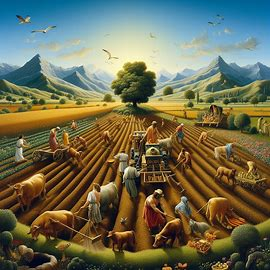In the annals of human history, the domestication of plants and animals represents a pivotal moment in our journey from hunter-gatherers to agriculturalists. This transformative process laid the foundation for settled communities, surplus food production, and the rise of complex societies. Join us as we embark on a journey to explore the fascinating process of domestication and its profound impact on food production and human civilization.
Unraveling the Domestication Process:
The domestication of plants and animals was a gradual process that unfolded over thousands of years, driven by the ingenuity and resourcefulness of early human societies. It involved selectively breeding wild species for desirable traits, such as larger seeds, higher yields, docility, and suitability for domestication.
Plants: From Wild to Cultivated:
One of the earliest examples of plant domestication occurred in the Fertile Crescent, where ancient farmers cultivated wild grasses like wheat, barley, and rice. Through careful selection and cultivation, these wild ancestors were transformed into staple crops that formed the basis of early agricultural economies.
Animals: Taming the Wild:
Simultaneously, early humans began domesticating animals for various purposes, including food, labor, and companionship. Species like dogs, goats, sheep, cattle, and pigs were gradually tamed and bred for traits that suited human needs, such as milk production, wool, meat, and transportation.
Impact on Food Production:
The domestication of plants and animals revolutionized food production, enabling humans to transition from subsistence living to surplus agriculture. Domesticated crops and livestock provided a reliable food source, allowing populations to grow and settlements to flourish. This surplus food also supported the development of trade networks, specialization of labor, and the emergence of complex societies.
Cultural and Environmental Implications:
Beyond its economic significance, domestication had profound cultural and environmental implications. It fostered a closer relationship between humans and the natural world, shaping cultural practices, religious beliefs, and social structures. However, it also led to environmental changes, including habitat modification, loss of biodiversity, and the spread of invasive species.
Conclusion:
The domestication of plants and animals represents a remarkable chapter in human history, marking the beginning of our agricultural journey and the dawn of civilization. By exploring this process, we gain insights into the ingenuity and resourcefulness of our ancestors and the complex interplay between humans and the natural world. As we reflect on the legacy of domestication, we are reminded of the enduring impact of our agrarian heritage on modern society and the imperative to steward our planet's resources wisely.
Join us as we delve into the captivating story of
cultivation, from the wild origins of our agricultural ancestors to the
bountiful harvests of today.


Post a Comment